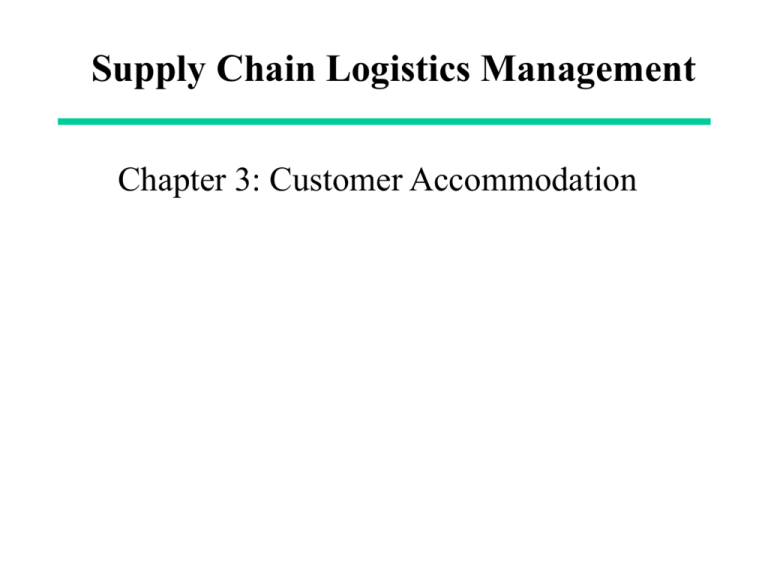
Supply Chain Logistics Management
Chapter 3: Customer Accommodation
Service Outputs: The Value Added
Different supply chains provide different levels of
service output to consumers/endusers:
1. Spatial Convenience
2. Lot size
3. Waiting time
4. Product variety (assortment width and
depth)
Supply Chain Logistics Management, First Edition , Bowersox, Closs, and Cooper
Copyright© 2002 by The McGraw-Hill Companies, Inc. All rights reserved.
Strategic Perspectives
• High level of Basic Service - The Platform
• Targeted Value-Added Satisfaction
• Growth through Customer Success
Supply Chain Logistics Management, First Edition , Bowersox, Closs, and Cooper
Copyright© 2002 by The McGraw-Hill Companies, Inc. All rights reserved.
3 Levels of Customer Focus
Basic Service
Satisfaction
Achieve internal standards (e.g.,
specified performance cycle of fill rate)
Meet customer expectations (e.g., arrive
on time with right product as measured
by the customer)
Success
Customers of choice achieve their objectives
(e.g., logistics operation can provide product
and service in a manner that ensures long
term customer viability)
Supply Chain Logistics Management, First Edition , Bowersox, Closs, and Cooper
Copyright© 2002 by The McGraw-Hill Companies, Inc. All rights reserved.
Basic Service Elements
• Availability
– Fill rates
– Stockouts
– Orders shipped complete
• Service Reliability
* damage
* mis-shipments
* etc.
• Operational Performance
–
–
–
–
Speed
Consistency
Flexibility
Recovery
Logistics Customer
Service Mix
Supply Chain Logistics Management, First Edition , Bowersox, Closs, and Cooper
Copyright© 2002 by The McGraw-Hill Companies, Inc. All rights reserved.
“Perfect Order” Achievement
• The “Perfect Order” Defined
– Complete Orders Delivered To Customers Requested
Date And Time In Perfect Condition, Including All
Documentation.
– .97 x.97 x.97 x.97 x.97 x.97 x.97 x.97 x.97 x.97=.73
Supply Chain Logistics Management, First Edition , Bowersox, Closs, and Cooper
Copyright© 2002 by The McGraw-Hill Companies, Inc. All rights reserved.
WHAT IS CUSTOMER SATISFACTION?
•SAT = F (Expectations, perceived performance)
•Perceived Performance - Expectations < 0, Dissatisfaction
•Perceived Performance - Expectations > = 0, Satisfaction
“Meet or Exceed Customer Expectations”
Supply Chain Logistics Management, First Edition , Bowersox, Closs, and Cooper
Copyright© 2002 by The McGraw-Hill Companies, Inc. All rights reserved.
A GENERIC PROFILE OF EXPECTATIONS
1. RELIABILITY
2. RESPONSIVENESS
3. COMPETENCE
4. ACCESS
5. COURTESY
6. COMMUNICATION
7. CREDIBILITY
8. SECURITY
9. TANGIBLES
10. KNOWING THE CUSTOMER
Supply Chain Logistics Management, First Edition , Bowersox, Closs, and Cooper
Copyright© 2002 by The McGraw-Hill Companies, Inc. All rights reserved.
SATISFACTION AND QUALITY MODEL
CUSTOMER
Word of Mouth
Communications
Requirements
Expectations
GAP 6
Perceived
Performance
GAP 5
GAP 4
Actual
Performance
SELLER
Past Experience
GAP 1
External
Communications
GAP 3
Performance
Standards
GAP 2
Management
Perceptions of
Expectations
Supply Chain Logistics Management, First Edition , Bowersox, Closs, and Cooper
Copyright© 2002 by The McGraw-Hill Companies, Inc. All rights reserved.
Customer Satisfaction
Performance
Expectation
LO
MED
HI
LO
Very Satisfied
Very Satisfied
Satisfied
MED
HI
Very Satisfied
Satisfied
Dissatisfied
Satisfied
Dissatisfied
Dissatisfied
Supply Chain Logistics Management, First Edition , Bowersox, Closs, and Cooper
Copyright© 2002 by The McGraw-Hill Companies, Inc. All rights reserved.
WHY CUSTOMER SATISFACTION IS
NOT SUFFICIENT
• It focuses on customer’s expectations - not
their real requirements
• Considerable research suggests that “satisfied”
customers still are likely to defect
• There is a tendency by companies to treat all
customers as being equal and identical
Supply Chain Logistics Management, First Edition , Bowersox, Closs, and Cooper
Copyright© 2002 by The McGraw-Hill Companies, Inc. All rights reserved.
Evolution of Management Thought
Philosophy
Focus
Customer Service
Meet Internal Standards
Customer Satisfaction Meet Expectations
Customer Success
Meet Customer Requirements
Notice that the satisfaction
model does not focus on
requirements
Supply Chain Logistics Management, First Edition , Bowersox, Closs, and Cooper
Copyright© 2002 by The McGraw-Hill Companies, Inc. All rights reserved.
Moving to Customer Success
Us
How can we help
our customers win?
Our
Customer’s
Customer
We’ll do whatever
they tell us
they want
Our
Customer
This is not our
problem (WRONG)
Supply Chain Logistics Management, First Edition , Bowersox, Closs, and Cooper
Copyright© 2002 by The McGraw-Hill Companies, Inc. All rights reserved.
Development of Logistical Competency
Stage 4
Stage 3
Market
Extension
Stage 2
Stage 1
Market
Creation
Market
Access
Gaining Costeffectiveness
0
5
10
Supply Chain Logistics Management, First Edition , Bowersox, Closs, and Cooper
Copyright© 2002 by The McGraw-Hill Companies, Inc. All rights reserved.
ACHIEVING CUSTOMER SUCCESS
• NOT ALL CUSTOMERS HAVE THE SAME REQUIREMENTS
• UNDERSTAND YOUR CUSTOMERS' REQUIREMENTS
• KNOW YOUR CUSTOMERS' PROCESSES
• HOW CAN YOUR CAPABILITIES ENHANCE CUSTOMERS'
PERFORMANCE
• NEW PERFORMANCE METRICS
Supply Chain Logistics Management, First Edition , Bowersox, Closs, and Cooper
Copyright© 2002 by The McGraw-Hill Companies, Inc. All rights reserved.












